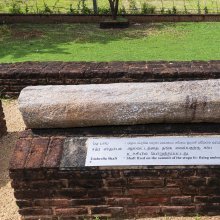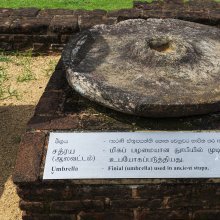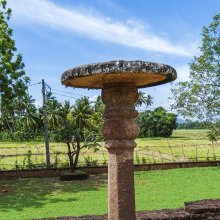Chattra: 12 definitions
Introduction:
Chattra means something in Buddhism, Pali, Hinduism, Sanskrit. If you want to know the exact meaning, history, etymology or English translation of this term then check out the descriptions on this page. Add your comment or reference to a book if you want to contribute to this summary article.
Alternative spellings of this word include Chhattra.
Ambiguity: Although Chattra has separate glossary definitions below, it also represents an alternative spelling of the word Cattra. It further has the optional forms Chāttra.
Images (photo gallery)
In Hinduism
Ayurveda (science of life)
Source: Wisdom Library: Āyurveda and botanyChattra (छत्त्र) is a Sanskrit word referring to “mushrooms” (various species). Caraka, in his Carakasaṃhitā sūtrasthāna 27, identifies this plant as part of the Śākavarga group of medicinal plants. This refers to the “group of vegetables/pot-herbs”. Caraka defined such groups (vargas) based on the dietic value of the plant. The carakasaṃhita is an Ayurvedic work on medicinal science.
Properties according to the Carakasaṃhitā: Various mushrooms except Sarpacchatraka (a type of mushroom) are cold, causing rhinitis, sweet and heavy.

Āyurveda (आयुर्वेद, ayurveda) is a branch of Indian science dealing with medicine, herbalism, taxology, anatomy, surgery, alchemy and related topics. Traditional practice of Āyurveda in ancient India dates back to at least the first millenium BC. Literature is commonly written in Sanskrit using various poetic metres.
Natyashastra (theatrics and dramaturgy)
Source: Wisdom Library: Nāṭya-śāstraChattra (छत्त्र) refers to an “umbrella”, which is an accessories used in a dramatic play, according to Nāṭyaśāstra chapter 23. Such accessories and weapons should be made by experts using proper measurements and given to persons in their respective conditions. It forms a component of āhāryābhinaya (extraneous representation).

Natyashastra (नाट्यशास्त्र, nāṭyaśāstra) refers to both the ancient Indian tradition (shastra) of performing arts, (natya—theatrics, drama, dance, music), as well as the name of a Sanskrit work dealing with these subjects. It also teaches the rules for composing Dramatic plays (nataka), construction and performance of Theater, and Poetic works (kavya).
Purana and Itihasa (epic history)
Source: archive.org: Shiva Purana - English TranslationChattra (छत्त्र) refers to an “umbrella” (for warding off obstacles), according to the Śivapurāṇa 2.2.25. Accordingly as Rāma narrated to Satī:—“[...] O Goddess, formerly once, Śiva, the creator supreme, called Viśvakarman to His highest region. He made him erect a large hall of great beauty in His cowshed, and an exquisite throne (siṃhāsana) there. Śiva, caused Viśvakarman to make an excellent, divine, wonderful umbrella for warding off obstacles”.

The Purana (पुराण, purāṇas) refers to Sanskrit literature preserving ancient India’s vast cultural history, including historical legends, religious ceremonies, various arts and sciences. The eighteen mahapuranas total over 400,000 shlokas (metrical couplets) and date to at least several centuries BCE.
Shaivism (Shaiva philosophy)
Source: Brill: Śaivism and the Tantric TraditionsChattra (छत्त्र) refers to the “parasol” (of one’s Guru) , according to the 13th-century Matsyendrasaṃhitā: a Kubjikā-Tripurā oriented Tantric Yoga text of the Ṣaḍanvayaśāmbhava tradition from South India.—Accordingly, “After this, O Śivā, hear the exposition of the Kula Conduct. After he has joined the tradition of the Siddhas, he should worship his guru as divine. The Yogin who is engaged in the worship of his guru can obtain the highest Power. The guru’s bedstead, his bedding, clothes, ornaments, sandals, parasol (chattra), antilope-skin, bowl or anything else: if he touches any of these with his feet, he should place them on his head and recite [mantras] eight times. [...]”.

Shaiva (शैव, śaiva) or Shaivism (śaivism) represents a tradition of Hinduism worshiping Shiva as the supreme being. Closely related to Shaktism, Shaiva literature includes a range of scriptures, including Tantras, while the root of this tradition may be traced back to the ancient Vedas.
In Buddhism
Mahayana (major branch of Buddhism)
Source: Wisdom Library: Maha Prajnaparamita SastraChattra (छत्त्र) refers to “parasols”, according to Mahāprajñāpāramitāśāstra (chapter 3).—Accordingly, “When the three baskets of the doctrine were brought together, the Devas, Asuras, Nāgas and Devis [Devīs?] made offerings of all kinds. They rained down celestial flowers (puṣpa), perfumes (gandha), banners (patākā), parasols (chattra) and heavenly garments (vastra), to pay homage to the doctrine. Then they recited this stanza: ‘Out of compassion for the universe the three baskets of the Dharma have been collected. The omniscient one who has the ten strengths (daśabala), the wisdom of his words is the lamp that destroys ignorance’.”.
Source: academia.edu: A Study and Translation of the GaganagañjaparipṛcchāChattra (छत्त्र) refers to a “(jewel) canopy”, according to the Gaganagañjaparipṛcchā: the eighth chapter of the Mahāsaṃnipāta (a collection of Mahāyāna Buddhist Sūtras).—Accordingly, “Then the Bodhisattva, the great being Gaganagañja together with the twelve koṭis of Bodhisattvas, having descended from the vault of the sky, bowed down at the feet of the Buddha, circumambulated him three times, and addressed himself to the Lord. [...] The Bodhisattva Gaganagañja then sustained (adhiṣṭhita) the jewel-canopy (ratna-chattra) of ten thousand yojanas high over the Lord’s lion throne in the sky, joined the palms of his hands, saluted, and praised the Lord with these suitable verses: [...]”.

Mahayana (महायान, mahāyāna) is a major branch of Buddhism focusing on the path of a Bodhisattva (spiritual aspirants/ enlightened beings). Extant literature is vast and primarely composed in the Sanskrit language. There are many sūtras of which some of the earliest are the various Prajñāpāramitā sūtras.
Languages of India and abroad
Sanskrit dictionary
Source: Cologne Digital Sanskrit Dictionaries: Benfey Sanskrit-English DictionaryChattra (छत्त्र).—i. e. chad + tra, usually written chatra chatra, I. n. A parasol, [Mānavadharmaśāstra] 2, 178; one of the insignia of a king, [Rājataraṅgiṇī] 5, 18. Ii. f. rā, The name of a plant, [Suśruta] 2, 170, 2.
--- OR ---
Chāttra (छात्त्र).—i. e. chattra + a, I. m. A pupil, [Pañcatantra] 34, 25. Ii. n. A kind of honey, [Suśruta] 1, 185, 1.
Source: Cologne Digital Sanskrit Dictionaries: Cappeller Sanskrit-English DictionaryChattra (छत्त्र).—[neuter] parasol (emblem of royalty).
--- OR ---
Chāttra (छात्त्र).—[masculine] pupil; [abstract] tā [feminine]
Source: Cologne Digital Sanskrit Dictionaries: Aufrecht Catalogus CatalogorumChāttra (छात्त्र) as mentioned in Aufrecht’s Catalogus Catalogorum:—poet. [Subhāshitāvali by Vallabhadeva]
Source: Cologne Digital Sanskrit Dictionaries: Monier-Williams Sanskrit-English Dictionary1) Chattra (छत्त्र):—a etc. See √chad.
2) [from chad] b m. ([Pāṇini 6-4, 97]; often spelt chatra) a mushroom, [cf. Lexicographers, esp. such as amarasiṃha, halāyudha, hemacandra, etc.]
3) [v.s. ...] Andropogon Schoenanthus, [cf. Lexicographers, esp. such as amarasiṃha, halāyudha, hemacandra, etc.]
4) [v.s. ...] a parasol-shaped bee-hive, [Horace H. Wilson]
5) [v.s. ...] n. a parasol, Chattar (ensign of royal or delegated power, [Jaina literature; Rājataraṅgiṇī v, 18; Purāṇa-sarvasva]), [Kātyāyana-śrauta-sūtra xxi, 3, 6; Gobhila-śrāddha-kalpa; Kauśika-sūtra; Āśvalāyana-gṛhya-sūtra iii, 8; Adbhuta-brāhmaṇa; Manu-smṛti] etc. (ifc. f(ā). , [Mahābhārata iii, 933])
6) [v.s. ...] n. an umbrella, [Cāṇakya]
7) [v.s. ...] a particular constellation, [Varāha-mihira’s Bṛhajjātaka xii, 8; Laghujātaka, by Varāha-mihira x, 8]
8) [v.s. ...] ‘shelter (of pupils)’, a teacher (a meaning derived [from] chāttra), [Pāṇini 4-4, 62; Patañjali]
9) Chattrā (छत्त्रा):—[from chattra > chad] f. Name of a plant growing in Kaśmir, [Suśruta i, 19, 27; iv, 30]
10) [v.s. ...] Anethum Sowa, [cf. Lexicographers, esp. such as amarasiṃha, halāyudha, hemacandra, etc.]
11) [v.s. ...] Asteracantha longifolia, [cf. Lexicographers, esp. such as amarasiṃha, halāyudha, hemacandra, etc.]
12) [v.s. ...] Rubia Munjista, [cf. Lexicographers, esp. such as amarasiṃha, halāyudha, hemacandra, etc.]
13) [v.s. ...] a mushroom, [cf. Lexicographers, esp. such as amarasiṃha, halāyudha, hemacandra, etc.]
14) [v.s. ...] cf. ati-, ahi-, eka-, gomaya-, sita-
15) [v.s. ...] ākṛti-cchattrā.
16) Chāttra (छात्त्र):—[from chad] a m. ([from] chattra [q.v.] [Pāṇini 4-4, 62]) ‘sheltered’, a pupil, scholar, [Pañcatantra; Rājataraṅgiṇī vi, 87; Vopadeva]
17) [v.s. ...] n. a kind of honey, [Suśruta i, 45, 8, 2 and 6; Bhāvaprakāśa v, 21, 14.]
18) b ttraka, etc. See √1. chad.
[Sanskrit to German]
Sanskrit, also spelled संस्कृतम् (saṃskṛtam), is an ancient language of India commonly seen as the grandmother of the Indo-European language family (even English!). Closely allied with Prakrit and Pali, Sanskrit is more exhaustive in both grammar and terms and has the most extensive collection of literature in the world, greatly surpassing its sister-languages Greek and Latin.
See also (Relevant definitions)
Starts with (+15): Chattrabha, Chattrabhanga, Chattracakra, Chattradana, Chattradarshana, Chattradhanya, Chattradhara, Chattradharana, Chattradharatva, Chattradharin, Chattradi, Chattraganda, Chattragomin, Chattragrahini, Chattragriha, Chattraguccha, Chattrahaya, Chattramitra, Chattramukha, Chattranilaya.
Query error!
Full-text (+67): Chattramitra, Chattradarshana, Chattraganda, Chattradharana, Chattradhara, Chattravriksha, Chattradharin, Brihakchattra, Chattrata, Chattravyamsaka, Chattranilaya, Chattrapushpaka, Chattragriha, Chattrasimha, Chattradhanya, Chattrasala, Chattramukha, Chattracakra, Chattraguccha, Chattrabhanga.
Relevant text
Search found 11 books and stories containing Chattra, Chāttra, Chattrā; (plurals include: Chattras, Chāttras, Chattrās). You can also click to the full overview containing English textual excerpts. Below are direct links for the most relevant articles:
Amarakoshodghatana of Kshirasvamin (study) (by A. Yamuna Devi)
Flora (12): Mushrooms < [Chapter 5 - Aspects of Nature]
Daily Life (1): Food and Drinks < [Chapter 3 - Social Aspects]
Maha Prajnaparamita Sastra (by Gelongma Karma Migme Chödrön)
Eleventh aṅga (member): Adbhutadharma < [Part 2 - Hearing the twelve-membered speech of the Buddha]
Appendix 6 - The story of Śaivala, son of Amṛtā (aunt of the Buddha) < [Chapter XXXIX - The Ten Powers of the Buddha according to the Abhidharma]
II. Metonymical meaning of kuśalamūla (‘roots of good’) < [Part 1 - Honoring all the Buddhas]
The Sun-Worshipping Sakadvipiya Brahmanas (by Martina Palladino)
Khadira-grihya-sutra (by Hermann Oldenberg)
Devi Tantra, Mantra, Yantra (study) (by Srider Basudevan Iyer)
Hitopadesha (English translation) (by Sir Edwin Arnold)
Chapter 1 - The Story of the Lion, the Jackals, and the Bull < [Book Two - The Parting of Friends]


